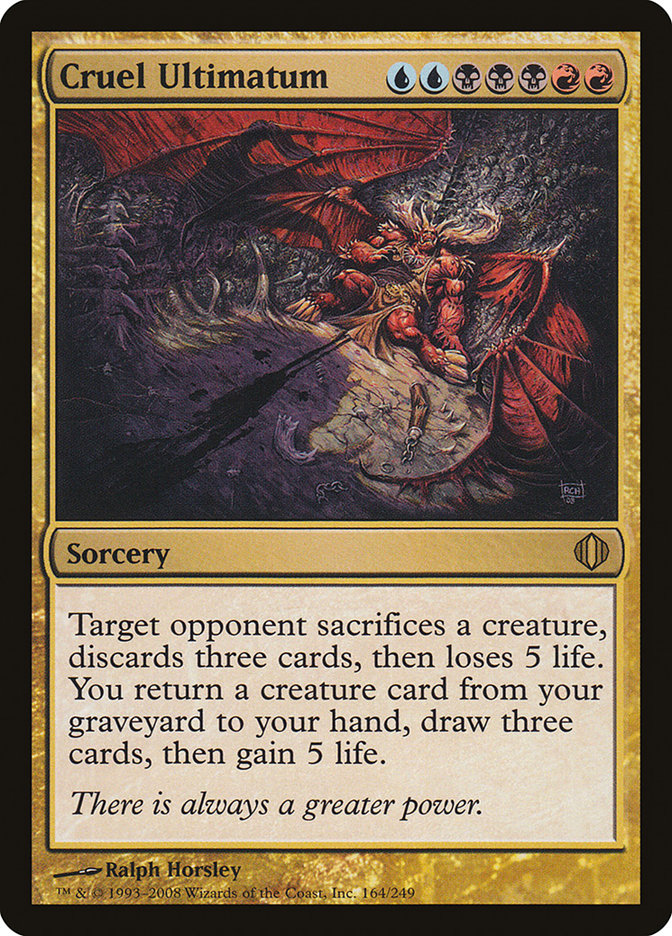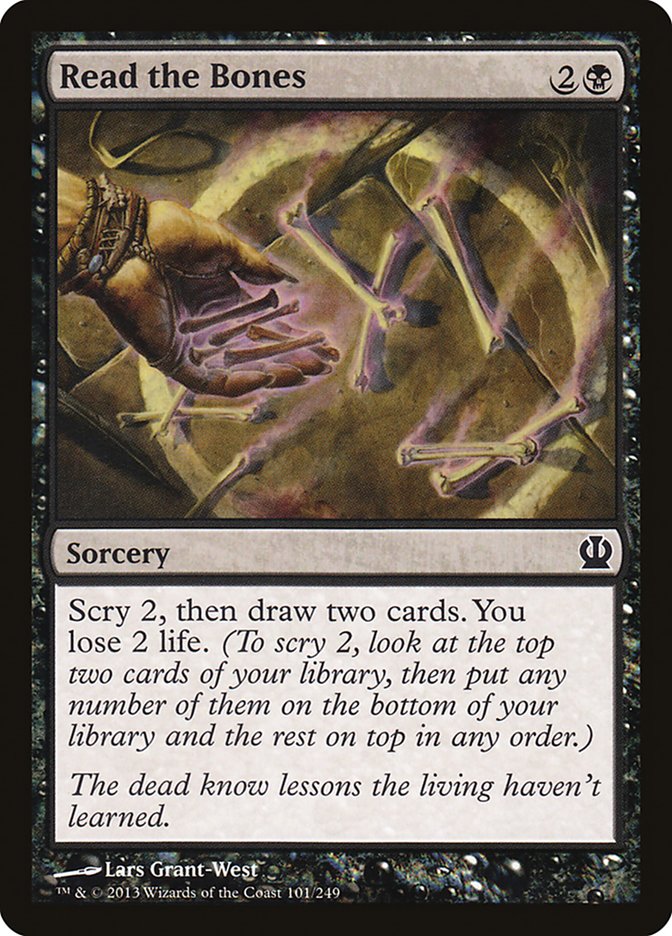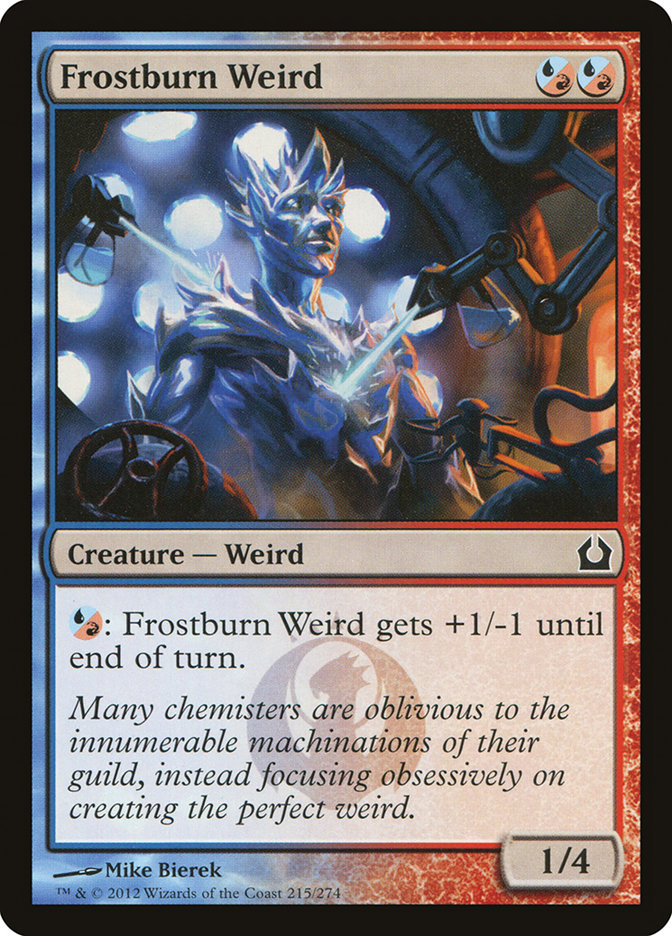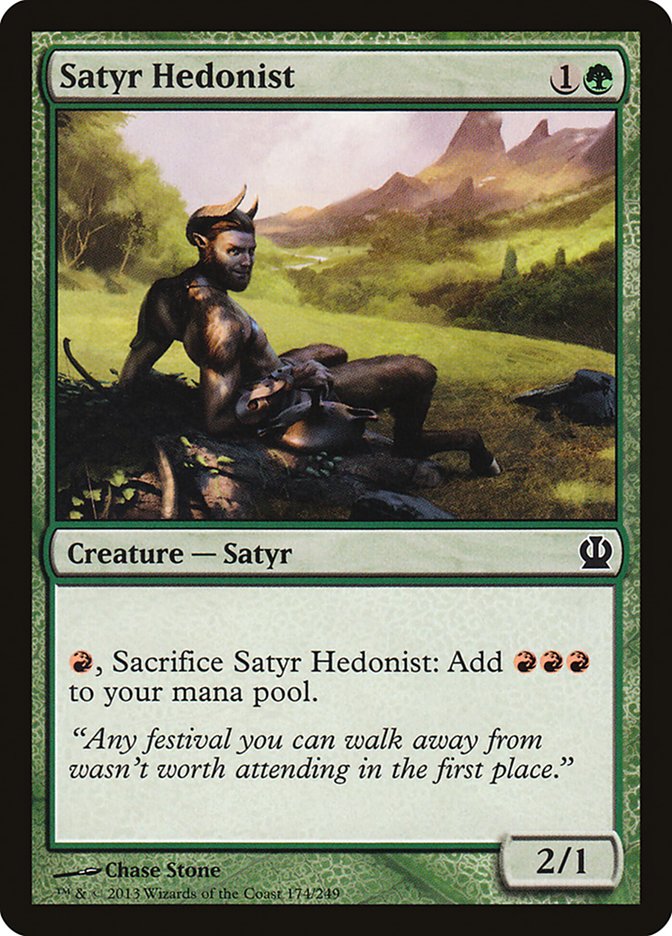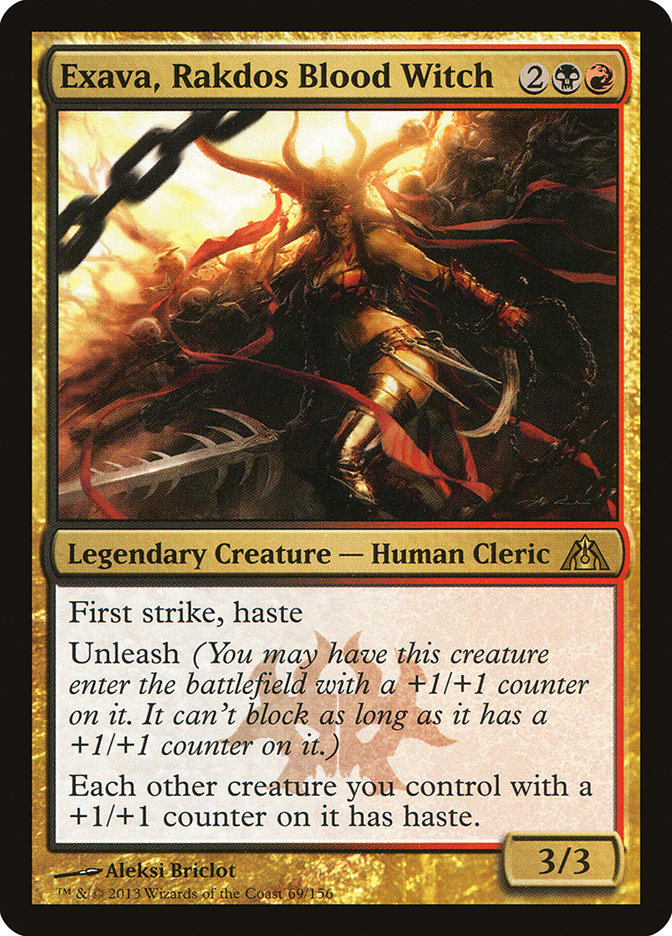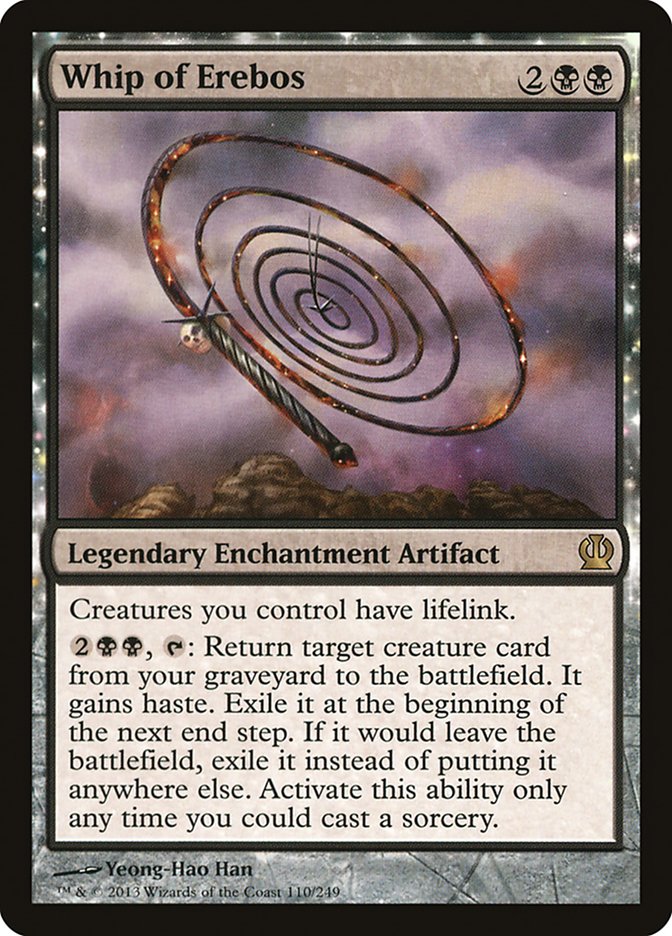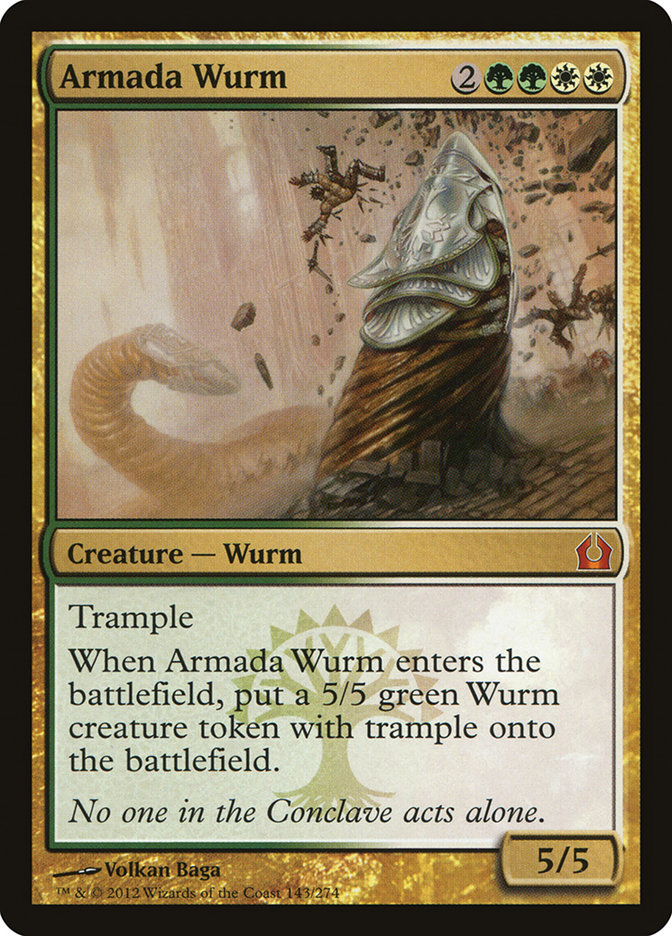Now that I’ve had a chance to play some Theros Standard, I’ve learned one key thing.
The mana really sucks.
I know that’s not necessarily something new. A lot of people have discussed how the loss of an entire block is going to hurt the easygoing three-color mana bases we used to know and occasionally love. The thing is that I didn’t exactly believe them. I thought that maybe they were being overdramatic. The mana couldn’t be that bad.
It turns out that I was right. Sort of. The mana actually isn’t that bad. You can assemble the right colors you need for your tricolor list. It’s just pretty painful to do so. I mean that both literally and figuratively. Playing the full twelve shock lands means you will deal a lot of damage to yourself, but it’s very hard to play a tricolor list without them. In the last Standard format, we could just play eight or ten shock lands and get away with it because of the buddy lands. Not anymore.
In fact, every three-color deck I have built thus far has struggled with the inherent pain in assembling your colors. Either you’re a turn behind because you’re playing all of your lands tapped or are putting your opponent a turn ahead by dealing six damage to yourself. Thragtusk isn’t around anymore. Twenty life is like a drop of rain in the desert. It evaporates quickly.
“Aha!” you say. “Why don’t you just sculpt your plays so that a lot of your shock lands can come into play tapped? Then you don’t have to take damage from them and still get your mana fixing!”
That sounds like a swell strategy. It has but one flaw. It’s hard to sculpt your turns to play your shock lands tapped when you already have to play other lands that can only come into play tapped. Twelve shock lands alone isn’t enough to provide the mana fixing you need for a three-color list. In addition, you will need to supplement your mana base with Temples or Guildgates. Those lands always come into play tapped. Turns where you have an extra mana left open are going to be used playing these lands, not shock lands. The other turns you will likely have to shock yourself to play your cards on curve.
It’s usually about six damage a game. That’s not trivial.
That also hasn’t stopped me. They don’t call me Brian “The Greed Steed” Braun-Duin for nothing. Well, actually nobody has ever called me that. But if they did, it certainly wouldn’t be for nothing. There’s really nothing better than drinking a nice cold cup of lemonade on a relaxing summer day and snapping off a loose keep with your greedy three-color deck. That’s Magic as it was meant to be played.
So while these lists may simply be flawed because of the constraints of the mana we have to work with, I’m still trying to make shock happen anyway. I thought I’d share with you what I have so far. Even if these lists don’t ultimately pan out to be huge metagame forces, they still are good learning tools. I also feel like they have the potential to thrive in the right environment even if the mana sucks.
Grixis Super Friends
One thing you may not know about me is that I loved playing Cruel Ultimatum. I played Grixis Cruel Control for a fairly extended period of time back in Shards/Zendikar Standard. Sure, the deck may have been second fiddle to Jund, but I still loved playing it. I mean, have you seen Cruel Ultimatum?
Grixis has typically been a control shell that lacks a sweeper effect. As a result, you tend to have to build your deck to have a stronger impact on the board since you can only rely on spot removal to handle your opponent’s threats. You don’t have a sweeper to clean everything up; you need your big-impact cards to do that.
I built this list with that general idea in mind. There are a lot of strong planeswalkers in Standard right now, and without Flinthoof Boar, Hellrider, Strangleroot Geist, and Thundermaw Hellkite around, it could easily be time for planeswalkers to make an impact on Standard again. I can only hope so. Planeswalkers are awesome.
This list is what I played in the Versus video that comes out this week. I built it because I thought Ashiok, Nightmare Weaver might be a strong card and wanted to try it out. Coupled with a lot of people asking to see Ashiok, it seemed like the perfect fit. I figured what better way to play Ashiok then to just throw it in a deck with some of the most powerful friends a planeswalker can buy.
Creatures (4)
Planeswalkers (11)
Lands (26)
Spells (19)
Sideboard

The first thing I learned is that Read the Bones isn’t very good. I do think the card is very powerful. It may end up being one of the best cards in the set. It just isn’t right in a deck that’s pinging itself for so much damage with lands. Shocking yourself down to twelve and then casting Read the Bones to drop to ten just isn’t a winning proposition against any form of aggression.
Frostburn Weird was awesome. The card is very good at playing defense, especially since extra mana lets you trade up or tear up creatures like Voice of Resurgence. Frostburn Weird also survives Anger of the Gods and is good at pressuring planeswalkers and life totals against control decks.
The planeswalkers are all really awesome. The one thing I didn’t like is the glut of walkers at the four-mana slot. Something like Mind Stone would be amazing in this deck. It’s also possible that I should trim the numbers on those planeswalkers and look for more three-mana options instead.
One of the aspects of this deck that became apparent to me is that four Anger of the Gods is a necessity. The reason isn’t simply that Anger is a good card or that people will be playing creatures that die to it.
The main reason is that Ashiok, Nightmare Weaver and Jace, Architect of Thought make Anger of the Gods so much better. Ashiok comes down on turn 3 and immediately jumps to five loyalty. Jace comes down on turn 4, jumps to five loyalty, and reduces the damage your opponent’s creatures will deal.
Both of these cards promote the same thing: overextension. If your opponent doesn’t kill these planeswalkers as soon as possible, they will lose to them. That pushes them to commit as many resources to the board as they can so this doesn’t happen. Since Ashiok and Jace have such high loyalty and come down so quickly, this means your opponent really has to dedicate a lot to dealing with them. A pair of bears isn’t enough. A sweeper effect is going to be really good at cleaning up all the creatures they have in play since they will have a lot. If they don’t, your planeswalkers are probably walking away with the game, and that should be acceptable as well.
In fact, sweepers seemed so good with Ashiok that I wanted to push in a different direction to really take advantage of the interaction. That led me directly to Shaheen Soorani basement, where I found lots of newspaper clippings, Top 8 pins, and old decklists. The clues I found in that basement all pointed to the same thing: Esper Control. It was time for this gripping thriller to get icy.
Esper Above-Average Friends
Creatures (2)
Planeswalkers (10)
Lands (19)
Spells (29)
- 4 Plains
- 4 Island
- 4 Azorius Charm
- 4 Supreme Verdict
- 3 Detention Sphere
- 3 Sphinx's Revelation
- 3 Far
- 3 Warped Physique
- 1 Hero's Downfall
Sideboard

The best card in the deck, which may come as no surprise, is Obzedat, Ghost Council. Following up a Supreme Verdict with an Obzedat is usually game over against anything. Obzedat can clear out planeswalkers and life totals fairly easily. While it may seem that he doesn’t play nicely with Elspeth’s -3 or Supreme Verdict, that’s not actually the case. Thanks to the power of Far // Away, you can often just pick up your Obzedat, clear the board away, and then plop his well-endowed tush back down again. He’s not fat; he’s just big boned. There’s also truly nothing like casting Far // Away to bounce your Obzedat and make them sacrifice a creature in response to their removal spell. That’s game!
The biggest downside to the deck—outside of the aforementioned mana base—is that sometimes you are put in a situation I like to call “what’s the verdict on Verdict?” Some also refer to it as “Verdict or bust.” Basically, a lot of decks apply so much pressure that a Warped Physique here or an Azorius Charm there just isn’t enough to match the pressure they are applying. Essentially, you have to play a Supreme Verdict to take care of their board or just die.
While the full four are present, you won’t always have one. Worse yet, you won’t always have the mana to cast one if you do draw it.
Another three-color deck I gave the ol’ college try is a brew I like to call “Turbo Sire”
Give Me Fuel, Give Me Sire, Give Me That Win I Desire
Creatures (30)
- 4 Exava, Rakdos Blood Witch
- 4 Sire of Insanity
- 4 Elvish Mystic
- 4 Kalonian Hydra
- 4 Satyr Hedonist
- 2 Polukranos, World Eater
- 4 Sylvan Caryatid
- 4 Stormbreath Dragon
Lands (19)
Spells (11)

The goal here is to utilize mana ramp to quickly accelerate into powerful aggressive creatures. Much like the G/W Elves deck of last Standard season, a turn 3 Kalonian Hydra is hopefully powerful enough to take over a game. Satyr Hedonist can produce a turn 3 Dragon or Hydra by itself. Hedonist alongside an Elvish Mystic can produce a turn 3 Sire of Insanity. Most decks are ill-equipped to deal with a Craw Wurm in play that early. Or rather, they are when they don’t have a hand anymore.
The deck also features a few other interactions. Exava, Rakdos Blood Witch combos well with Kalonian Hydra by letting you attack with Hydra the turn you play it. Kalonian Hydra also plays well with Whip of Erebos. If you Whip a Hydra back into play, you get to hit them for eight and gain eight.
Sire of Insanity not only plays well with all of the acceleration but also plays well with Whip of Erebos. If you cast a Sire with a Whip in play, you can still get value out of all the creatures you discard. If you Whip back a Sire, you can still make them discard their hand in the end step before exiling the Sire.
Satyr Hedonist not only can provide you with a giant boost in mana for a turn but is also just a perfect fit with Mizzium Mortars. Overloading Mizzium Mortars is a huge effect, and it’s much more powerful when you’re doing it on turn 4.
Overall, the deck has a lot of neat ideas, but it just didn’t quite come together. Too often my mana producers would die, and then I would be stuck with sixteen fresh copies of Sire of Insanity in my hand on three lands and die.* Other games I would have fourteen lands and 38 mana producers in play, just waiting patiently for the day I might draw that dreaded Sire of Insanity I thought I remembered putting in the deck. I’ve never known a deck that could so easily transition between being mana-screwed and flooding out without ever hitting the midpoint between the two until this one.
With that being said, I do plan on revisiting the idea at some point. I feel there is a lot of potential here, and if I can figure out the right mix of cards, it could end up being a powerhouse. I also want to point out that Exava, Rakdos Blood Witch was awesome. Even in games where the rest of the deck wasn’t functioning at peak performance, Exava was still out there doing her damnedest to patch things together.
Really, she was doing what I would expect a Blood Witch to do best. She was killing planeswalkers, hitting for four points of damage, and spending not even a moment blocking. She really fit that Blood Witch stereotype, and I for one was glad she did. You won’t ever find Exava playing in a Block Constructed Daily Event on Magic Online. Can’t Block. Won’t Block.
The last three-color monstrosity I want to share is near and dear to my heart. What kind of a person would I be if I didn’t at least take a stab at some sort of Reanimator deck? A terrible person, that’s what. Thragtusk, Restoration Angel, and Unburial Rites are all gone, but the dream lives on. Grisly Salvage decided to stick around, and that’s good enough for me.
Cool ReaniWhip
Creatures (20)
- 4 Lotleth Troll
- 2 Angel of Serenity
- 2 Armada Wurm
- 2 Obzedat, Ghost Council
- 4 Elvish Mystic
- 2 Shadowborn Demon
- 4 Sylvan Caryatid
Lands (18)
Spells (22)

The idea of this deck is pretty straightforward. You use Commune with the Gods and Grisly Salvage to dig through the deck and fill up the graveyard. Commune with the Gods can get Whip of Erebos, and both can find creatures.
Whip of Erebos lets you rebuy all those creatures you previously dumped in the graveyard. Lotleth Troll also lets you throw away creatures to grow the Troll, and Whip allows you to then just put those creatures right back into play. This is especially cool with Obzedat since you can draw him, discard him, Whip him, drain ’em, smack ’em, and then reuse him. I’m like 83% sure Daft Punk did a song about that.
This effectively allows you to give Obzedat haste the turn you play him. Pretty saucy, if you ask me. He also has lifelink, so you get to hit for seven and also gain seven in the process. I can’t even call that the “drain and brain” since it’s mostly just straight braining. They just die to that kind of thing. That’s not the kind of thing you just “shrug off.”
Armada Wurm also makes a triumphant return to playability in this deck. Even Rakdos himself approves of the return, and he has pretty high standards for that kind of thing. One of the big downsides of Armada Wurm in the past was that it mostly just traded off with a Thragtusk. For a creature with this prohibitive of a mana cost, that’s kind of a big deal.
No more. Thraggle Rock is gone, and Angel of Serenity, another predator of Armada Wurm, isn’t even being talked about by anyone. It feels like this might finally be the time for Armada Wurm to see some solid Standard play. Ten power is a lot when we’re talking about the two Wurms having lifelink thanks to Whip of Erebos. Also, if you Whip an Armada Wurm back into play, you get to keep the Wurm token even when you exile the Armada Wurm at end of turn. Cool beans.
When I played the deck, I discovered that Whip was just too slow. I was pretty much never Whipping things because I just didn’t have time. Having said that, I was still winning most games simply because using Grisly Salvage and Commune with the Gods to dig up some of the most powerful creatures in Standard and then using mana acceleration to play them ahead of schedule is still a pretty solid plan B.
Whip of Erebos providing lifelink was also very clutch. I’d play that card for that ability alone. It’s just so good.
Moving forward, I’d like to try a version that plays Rescue from the Underworld. Between all the mana dorks and Lotleth Troll, there are plenty of random creatures lying around to use with Rescue, and Lotleth Troll is also a great way to fill up the graveyard. I think Whip still deserves a place, but perhaps it shouldn’t be the only tool available for reanimating these guys. I felt like I had too many ways to put creatures in my graveyard and not enough to pull them back out. Hopefully Rescue from the Underworld can save me from that problem.
Without access to Fiend Hunter anymore, I felt it was necessary to play both Doom Blade and Hero’s Downfall. Essentially, I wanted to make sure that I could always kill a Scavenging Ooze since that card is extremely potent against Whip of Erebos. Beyond that, having removal is rarely a bad thing. Only against the pure control decks would I wish that Hero’s Downfall were just another threat instead.
Ultimately, I think this idea has a lot of promise. There are a lot of powerful creatures, such as Angel of Serenity and Shadowborn Demon, that people have just kind of ignored. I know the last time Angel of Serenity went ignored she ended up coming back to dominate the Standard scene for a couple of months. I wouldn’t be surprised to see that again. The card is still quite good.
That’s all I’ve got for today. Hopefully you were able to get something out of my decks and the things I have learned from them so far. While today I focused on a number of greedier three-color lists, next week I intend to focus on both the results from the first Standard event in Worcester and some more consistent two-color lists I’ve been working with. Rest assured, B/W will be among them.
There Will Be Obzedat.
Brian Braun-Duin
@BraunDuinIt in the dream world of Twitter
BBD in the nightmare world of Magic Online
*Before you try to tell me that sixteen copies of Sire of Insanity in hand is against the rules of Magic: The Gathering, I want to make one thing clear—I had a Reliquary Tower in play, so it was cool.

